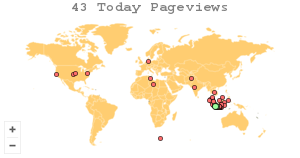SAINS DALAM ALQURAN
(Memahami Kontruksi Pendekatan Tafsir bil-Ilmi Dalam Menafsirkan Alquran)
DOI:
https://doi.org/10.47498/bashair.v1i1.574Keywords:
Qur'an, sain, Tafseer bil 'ilmiAbstract
The interpretation of the Qur'an with the approach of bil'ilmi interpretation is one of the interpretation patterns in today's contemporary. This is more because of the development of technology and science that in contemporary times is felt very strongly. but. In fact, the development of this bil'ilmi interpretation approach has begun to appear in classical times, where one of the figures who played an important role in his birth was Imam Al-Ghazali. The presence of this interpretation of bil 'ilmi approach does not necessarily go according to the expected there are also pros and cons. Regardless of the support or rejection of this interpretation of bil 'ilmi, of course information about the existence of science has been explained in some letters in the Qur'an. one example is the process of human creation. In some verses God clearly explains how man's creation from the beginning until the formation of man was perfect. The phenomenon of human formation has been described in the Koran as about 1400 years ago, and its evidence in modern times today by using sophisticated tools such USG (Ultrasonografi ) tools both in the form of 2,3,4 dimensions used to see the development of fetuses in the womb. Qur'an is a book that provides a source of inspiration about science, where people in this case are instructed to continue to think in digging the content in the Qur'an so that human thinking continues to develop. And most importantly the signs of science in the Qur'an to make people more believe in Allah almighty through the signs of his power in the context of knowledge.
References
al-Khattan. (t.t). Mabahith fi ‘Ulum Al-Quran. Riyad: Manshurat al-‘Asr al-Hadist.
Ash-Shiddieqy. (n.d.). Ilmu-Ilmu Alquran. Semarang: PT Pustaka Rizki Putra.
Baidan, N. (2015). Wawasan Baru Ilmu Tafsir. Yogyakarta: Pustaka Pelajar.
Fakhri. (2010). Sain dan Teknologi dalam Alquran dan Implikasinya Dalam Pembelajaran. jurnal Ta’dib, XV( 01), 124.
Fudhali, S. d. (2005). Pengantar Ilmu Tafsir. Bandung: Angkasa.
Ichwan, M. N. ( 2004). Tafsir ‘Ilmi: Memahami Alquran Melalui Pendekatan sains modern. Yogyakarta: Menara Kudus Jogja.
Khaeruman, B. (2004). Sejarah Perkembangan Tafsir Alquran (Pustaka Setia: Bandung, 2004). Bandung : Pustaka Setia.
Lajnah Pentashihan Alquran. (2013). Tafsir Ilmi: Waktu dalam perpektif Alquran. Jakarta: Lajnah Pentashihan Alquran.
Purwaningrum. (2015). Elaborasi Ayat-Ayat Sains Dalam Alquran: Langkah Menuju Integrasi Agama dan Sains Dalam Pendidikan. jurnal inovatif, 1(1), 133.
Rosadisastra, A. (2007). Metode Tafsir Ayat-Ayat Sains dan sosial (Jakarta: Amzah, 2007). Jakarta: Amzah.
Shihab, M. Q. (2002). Tafsir al-Misbah: Pesan, Kesan dan Keserasian Alquran (Vol. 9). Jakarta: Lentera Hati.
Sirajuddin, A. F. ( 2005). Pengantar Ilmu Tafsir. Bandung: Angkasa.
Thalhah, H. a. (2009). Ensiklopedia Mukjizat al-Qur’an dan Hadis (Kemukjizatan Penciptaan Manusia). Bandung: Sapta Sentosa.
Yuliarto. (2011). Al-Tafsir Al-ilmi Antara Pengakuan dan Penolakan. jurnal khatulistiwa, 1(1), 39.
Downloads
Published
Issue
Section
License
Authors who publish articles in Basha'ir: Jurnal Studi Al-Qur'an & Tafsir agree to the following conditions:
- The author retains copyright and grants the Basha'ir Journal the right from the first publication with the work simultaneously licensed under a Creative Commons Attribution-ShareAlike 4.0 International (CC BY-SA 4.0) license that allows others to make changes, adjust and build on the work with recognition of the author's work and initial publication in the Journal.
- Authors are allowed to copy and redistribute published versions of works in journals (for example, posting them to institutional repositories or publishing them in a book), with recognition of their initial publication in Basha'ir: Jurnal Studi Al-Qur'an & Tafsir.
- Authors are allowed and encouraged to post their work online (for example, in institutional repositories or on their websites) before and during the submission process, as it can lead to productive exchanges, and increase citations of published works






